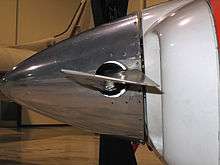Blade pitch
Blade pitch or simply pitch refers to turning the angle of attack of the blades of a propeller or helicopter rotor into or out of the wind to control the production or absorption of power. Wind turbines use this to adjust the rotation speed and the generated power. A propeller of a ship uses this effect to control the ship's speed without changing the rotation of the shaft and to increase the efficiency of streaming fluids.
Aircraft

In aircraft, blade pitch is usually described as "coarse" for a greater horizontal blade angle, and "fine" for a more vertical blade angle. For an aircraft that is stationary the angle of pitch of each blade of a propeller fitted to that aircraft equates to the angle of attack.
Blade pitch is normally described in units of distance/rotation assuming no slip.
Blade pitch acts much like the gearing of the final drive of a car. Low pitch yields good low speed acceleration (and climb rate in an aircraft) while high pitch optimizes high speed performance and economy.
A propeller blade's "lift", or its thrust, depends on the angle of attack combined with its speed. Because the velocity of a propeller blade varies from the hub to the tip, it is of twisted form in order for the thrust to remain approximately constant along the length of the blade; this is called washout. This is typical of all but the crudest propellers.
It is quite common in aircraft for the propeller to be designed to vary pitch in flight, to give optimum thrust over the maximum amount of the aircraft's speed range, from takeoff and climb to cruise.
Helicopter
In helicopters the pitch control changes the angle of attack of the rotor blades and thus the vertical acceleration or climb rate of the vehicle. This control is also called collective as distinct from the cyclic control for lateral movement. The collective blade setting is mostly achieved through vertical movement of the swashplate.
Feathering
Feathering the blades of a propeller means to increase their angle of pitch by turning the blades to be parallel to the airflow. This minimizes drag from a stopped propeller following an engine failure in flight.
Wind turbines

Blade pitch control is a feature of nearly all large modern horizontal-axis wind turbines. While operating, a wind turbine's control system adjusts the blade pitch to keep the rotor speed within operating limits as the wind speed changes. Feathering the blades stops the rotor during emergency shutdowns, or whenever the wind speed exceeds the maximum rated speed. During construction and maintenance of wind turbines, the blades are usually feathered to reduce unwanted rotational torque in the event of wind gusts.
Boating
Some composite propellers have interchangeable blades, which enables the blade pitch to be adjusted. Changing the blade pitch in different elevations can be very beneficial to a boater. Typically, using a lower pitch will provide better acceleration and a higher pitch enables better top end speed.
External links
.